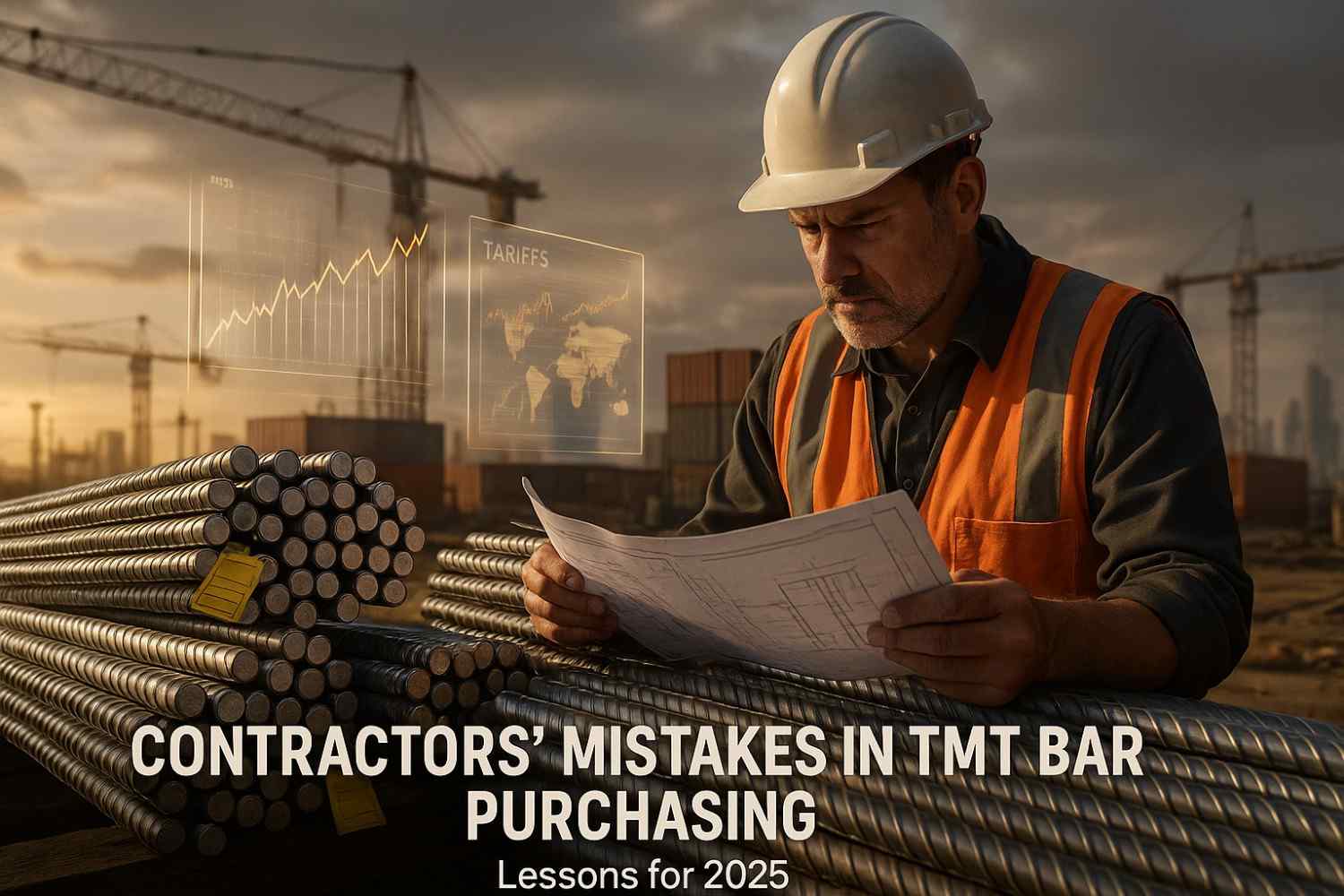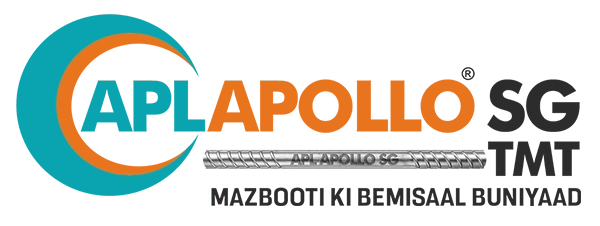
Introduction
In 2025, the steel industry is no longer just about local supply and demand. Global trade wars, import surges, government policies, and even diplomatic tensions now influence the price and availability of TMT bars in India.
Contractors who fail to account for these macro forces find themselves exposed to unexpected cost overruns, delays, and structural risks. In this article, we bring a news-analysis lens to the topic of purchasing TMT bars, blending market intelligence, policy dynamics, and contractor best practices.
As a Structural Steel Product Manager with over 12 years’ experience on-site in major infrastructure projects, I’ve seen how a shift in import duty or a sudden tariff can derail a project’s steel budget overnight.
In what follows, you’ll find:
- The latest global & national developments shaping Indian steel prices
- How those affect TMT bars specifically
- The persistent contractor mistakes in procurement
- Proactive strategies to avoid errors using data & foresight
Global & National Forces Reshaping the Steel Market
U.S. Tariffs, Export Diversion & Impact on India
- In 2025, U.S. tariffs on steel and aluminum (some under Section 232) are reshaping trade flows worldwide. S&P Global warned that some of the surplus steel may be redirected to India, potentially depressing local margins. Reuters
- However, Indian officials have stated that U.S. tariffs have limited direct impact on Indian steel, because India exports little to the U.S. Instead, Europe’s upcoming carbon border adjustment (CBAM) could affect Indian exporters more heavily.
- India is also pushing countermeasures: It has notified the WTO that it might impose retaliatory duties on certain U.S. goods in response to steel tariffs. The Economic Times
Implication for contractors: Even if direct tariffs aren’t biting your procurement now, steelmakers are under pressure. If their margins shrink, they may pass costs to downstream clients (i.e. you).
H3: Cheap Imports, Safeguard Duties & Domestic Policy Interventions
- India’s domestic market has been flooded by cheaper imports of steel from China, South Korea, and Japan – putting pressure on local mills.
- In response, in April 2025, India imposed a 12% safeguard duty on steel imports for 200 days. This tightened the import floodgates and allowed domestic prices to rebound. India Brand Equity Foundation
- More recently, India introduced the “Domestically Manufactured Iron & Steel Products Policy 2025”, mandating that government tenders prioritize locally produced steel – a major boost to domestic TMT and structural steel manufacturers.
- The government is also considering doubling the safeguard duty from 12% to 24% to further protect the industry.
Data snapshot:
- India is projected to see 8.5% growth in steel demand in 2025, compared to just ~1.2% globally.
- Steel prices are expected to average ₹52,000–₹53,000 per tonne in FY26–FY27, slightly lower than current high spot levels.
Contractor takeaway: Policy moves and duties can temporarily stabilize domestic steel pricing, but margins, supply bottlenecks, and demand spikes still create volatility. Procurement plans must build in buffer margins and time hedges.
How These Macro Trends Amplify Common Procurement Mistakes
With external pressures shifting, the usual mistakes contractors make when buying TMT bars carry even higher risks. Below are key errors, reframed in today’s market environment, and practices to counter them.
Mistake 1 — Treating All TMT Bars the Same Despite Grade & Project Differences
Under normal conditions, using Fe 500 vs Fe 550 or Fe 500D / Fe 550D may matter moderately. Under volatile markets, choosing the wrong grade can magnify cost impact.
Fe 550D, for instance, requires stricter manufacturing controls — when raw material costs rise, margins thin faster.
Using a lower-grade TMT bar in a high-stress zone (e.g., near coasts or seismic areas) may require retrofitting, which multiplies costs.
Avoidance tip: Always match grade to structural requirement. If your category is infrastructure, opt for APL Apollo SG INFRA (Fe 500D / Fe 550D) rather than general TMT.
Mistake 2 — Over-reliance on Price Alone in a Shifting Market
In past years, contractors might have prioritized the lowest bid. In 2025, that’s risky:
Steelmakers may cut corners if margins thin.
Uncertified suppliers become tempting, but their bars may fail quality tests.
Hidden tariffs or supply chain costs get passed downstream.
Best practice: Use total cost evaluation — price + certifications + delivery reliability + opportunity cost of delays.
Mistake 3 — Failing to Lock in Prices or Hedging Procurement
Given price swings, waiting to buy “at the bottom” can backfire. Steel peaks quickly in response to demand surges or raw material shortages.
Counter-strategy:
Negotiate forward contracts with trusted suppliers.
Use partial prepayments or buffer stock to lock earlier rates.
Retain supplier flexibility but cap exposure.
Mistake 4 — Ignoring Mill Test Certificates & Chain-of-Custody
When demand is tight, some unscrupulous suppliers may mix grades or avoid quality processes.
Always demand MTC (Mill Test Certificate) and proof of quenching process.
Trace back to the mill — if supply chain issues occur (tariffs, export restrictions), you want to have proof.
Mistake 5 — Improper Storage & Handling in Pressure Times
Even high-quality bars lose value if stored improperly. With global uncertainty, longer lead times are common; bars may sit on-site longer than predicted.
Keep TMT bars off the ground, under cover, separated from moisture.
Rotate stock to use older bars first.
Inspect for rust, cracks, or corrosion before use.
Case in Point: A Real Project Under Stress
In a mid-size infrastructure project in Gujarat (2024–25), I advised a contractor to allocate 5% buffer steel because of anticipated import-duty swings. When global scrap prices surged and Chinese import surpluses flowed into Indian ports, the local steel mills raised prices. The buffer allowed the project to continue without halting procurement.
If they had had no buffer, they would have faced 10–15% cost overruns and delays while re-bidding segments.
This is the kind of real-world pressure that macro trends impose on steel procurement decisions.
Frequently Asked Questions (FAQs)
Global tariffs, particularly the U.S. sanctions and duties on Indian steel exports, can impact raw material costs and supply dynamics. In 2025, these measures may lead to short-term price volatility in India’s TMT bar market. However, India's strong domestic production capacity and government-backed infrastructure projects will help stabilize long-term prices.
Contractors often overlook factors like BIS certification, grade (Fe 500, Fe 550, etc.), source credibility, and corrosion resistance. They also make the mistake of comparing only price instead of long-term structural performance. Always prefer trusted brands like APL Apollo SG TMT, which offer quality assurance and consistent grade integrity.
Government-led infrastructure projects under schemes like ‘PM Gati Shakti’ and ‘Bharatmala’ significantly increase TMT bar demand. As India continues to invest heavily in urban infrastructure, demand for Fe 550D and Fe 500D TMT bars is expected to grow steadily through 2025 and beyond.
Contractors can minimize risk by sourcing directly from authorized distributors, negotiating bulk purchase rates, and monitoring steel index updates. Partnering with established suppliers like APL Apollo SG TMT ensures steady supply, verified quality, and transparent pricing even during market fluctuations.
Strategic Recommendations for Contractors in 2025
Use Benchmark Indices & Proxy Price Tracking
Monitor trading indices like steel futures & scrap indices (e.g. TradingEconomics steel data). Trading EconomicsPartner with Certifiable and Flexible Suppliers
Suppliers whose operations aren’t vulnerable to sanctions or export blockades are more reliable.Structured Procurement Timeline
Spread procurement across time — e.g., 30% early, 30% mid, 40% close to usage — to average out price impact.Advocate for Domestic Preference
Leverage “Domestically Manufactured Steel” policies in your bids to gain preferential treatment. ReutersInclude Contingency in Budget
Plan for 8–12% variation in steel pricing due to tariffs, supply shocks, or import competition.
Conclusion
In 2025’s volatile steel environment, purchasing TMT bars is no longer a routine procurement—it’s a strategic decision. The risk of missteps is magnified when macro trends, global tariffs, and import surges converge.
Contractors who continue to buy purely on price, ignore certifications, or fail to anticipate policy shifts are the ones bearing hidden losses.
For contractors and builders seeking reliable, high-integrity TMT supply, APL Apollo SG TMT Bars and APL Apollo SG INFRA (Fe 500D / Fe 550D) remain among India’s most trusted solutions, backed by documented quality, a strong distribution network, and commitment to transparency.
👉 Explore these product pages for more specification details:
📞 To discuss project-specific steel strategies or get a quote, reach us at:
Address: A-127, Sector-136, Nepz Post Office, Gautam Buddha Nagar, Noida, Uttar Pradesh – 201305
Phone: 9266157778
Disclaimer: The content in this article is for informational purposes only. While based on current publicly available data (2024–2025) and professional insight, market conditions may change. Contractors should consult structural engineers, legal advisors, and verified suppliers before making procurement decisions.




Pingback: Smart Stocking Strategies for Dealers | Beat the TMT Bar Price Surge 2025